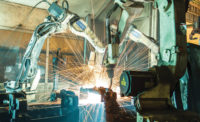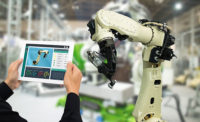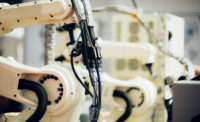The demands on facility managers for a spotless, clean facility seems to know no end. The need for high-quality cleaning and disinfection within a facility are at an all-time high, putting a strain on managers and employees and subsequently threatening facility productivity.
An emerging technology trend can help facility managers address the pressure and responsibility to uphold sky-high cleaning standards —automation. Some tasks are best performed by people, while others should be automated, allowing workers to focus on more core-business activities. Consider routine cleaning of a facility; not only can it be tedious and time-consuming, drawing workers away from production, but prolonged exposure to cleaning products is both undesirable and dangerous. Autonomous robotic cleaning solutions create a safe and healthy workplace while maximizing valuable employee hours. Facilities are only just scratching the surface when it comes to realizing the potential of robots.
Autonomy breeds productivity
Keeping facilities clean is no easy task these days. Building owners and facility managers face rising labor costs coupled with struggles to hire and retain their workforce. There’s also growing pressure to maintain first-class operating standards while meeting demand. These challenges have spurred a demand for automation when it comes to cleaning facilities.
For decades, automation has unlocked significant financial and operational benefits. Leading facilities are now turning to autonomous cleaning solutions to unlock new operating efficiencies. Autonomous solutions help organizations improve productivity and reduce costs, making their operations run faster and more reliably.
Take conventional floor cleaning as an example. With a manual scrubber an employee spends hours each shift driving the machine around cleaning the floors. Alternatively, floor-scrubbing robots clean autonomously; hours saved can be reallocated to higher-value tasks such as cleaning and disinfecting restrooms, offices, meeting rooms and break rooms.
Surface disinfection via autonomous sprayers is also on the rise. Electrostatic spraying technology is leveraged to ensure uniform 3-D coverage of surfaces, including hidden and indirectly sprayed ones for complete coverage. Autonomous electrostatic application ensures disinfection chemicals do not dry out in the air before reaching the target, effectively covering and ensuring proper dwell time on high-touch surfaces. Sprayers also use less chemical solution compared to traditional methods.
In today’s busy world, there is simply no time to do things inefficiently or waste valuable employee hours doing tedious and repetitive tasks. Automation provides an answer.
No more “you missed a spot”
Implementing the latest technology can go a long way in improving the speed and efficiency at which a facility is cleaned. But many facilities must clean thousands of square feet of space. Missing an area not only increases the amount of dust, dirt and debris collecting — it presents potential health and safety concerns. How do you know if you're missing spots?
Consider how you ensure other operations at your facility are completed as required: data. From production logs to employee timesheets, analytics and data are used every day to measure and optimize a variety of tasks and processes. Why should cleaning be any different?
While manual cleaning procedures are subject to the whims and direction of the human operating them, robots always begin with a plan and report on the plan when the job is done. That plan can include mapping the cleanable areas of a facility and developing thorough custom cleaning plans for specific areas of the space. Once a plan is created, a robot simply requires the touch of a button to start cleaning fully autonomously, using data-driven insights as it goes to determine the best route to clean the space each time based on changing layouts and momentarily obstacles.
Not only does robotic data provide a more thorough clean — it provides a more measurable clean. Advanced robots can provide deep insights on everything from water usage to service interruptions to square footage cleaned and more. Precise cleaning matters more than ever nowadays; robots can provide the measurable clean and disinfection necessary to keep your facility safe and operational.
The future of autonomous cleaning: multi-application
Today, most advanced indoor autonomous mobile robots (AMRs) on the market are specialized, addressing and solving for a single application or service: cleaning, disinfection, security, shelf-scanning, material handling, etc. These robots are highly effective at completing the task at hand. However, they are limited to addressing a single use case.
Consider this: each of the applications listed above are expected to grow into the single-digit billions by 2026. If we are to keep up, robots must evolve to accomplish more than one task to deliver a beneficial ROI. Luckily, this transition may be easier than one expects. The sensor set and navigation capabilities of most AMRs are all similar, opening a door to combine multiple functionalities into a single robot. The future of robotics lies in multi-application robots that can provide more value to end customers when compared to popular single application robots roaming facilities today.
There are many analogs between the early computer market in the early 1970s and indoor AMRs today; single-purpose mainframes dominated the market at that time, similar to the single-purpose robots of today. Computers that supported multiple applications quickly took hold and delivered compelling value, making them a central part of our day-to-day lives. This value was derived not only from additional convenience, but also economics. The economics of multi-application robots are simple. Combining two applications on one robot can deliver significant savings. These savings can be realized since the primary application already pays for the navigation and the AMR itself. The additional application is merely a hardware and software extension that can be delivered at the fraction of the cost.
It’s anticipated that multi-application AMRs will lead the way, and this transformation will take the AMR industry to new heights while making AMRs an integral part of our day-to-day lives. In fact, it’s already happening. Innovative floor-scrubbing robots are being outfitted with disinfection add-ons, expanding the functionality past floor care to extensive disinfection of high-touch, 3-D surfaces.
Consider the benefits a multi-functional cleaning robot can offer a facility; adding disinfection functions on a multi-application cleaning robot can deliver the disinfection function to an end-customer for around 1/10th of the price of a single-purpose disinfection robot or manual disinfection.
The days of having single-purpose robots for specific tasks may soon be behind us. Multi-application robots are a natural progression to take a booming trend in autonomous solutions and make them more accessible and affordable to meet the ever-evolving needs of every facility manager.



